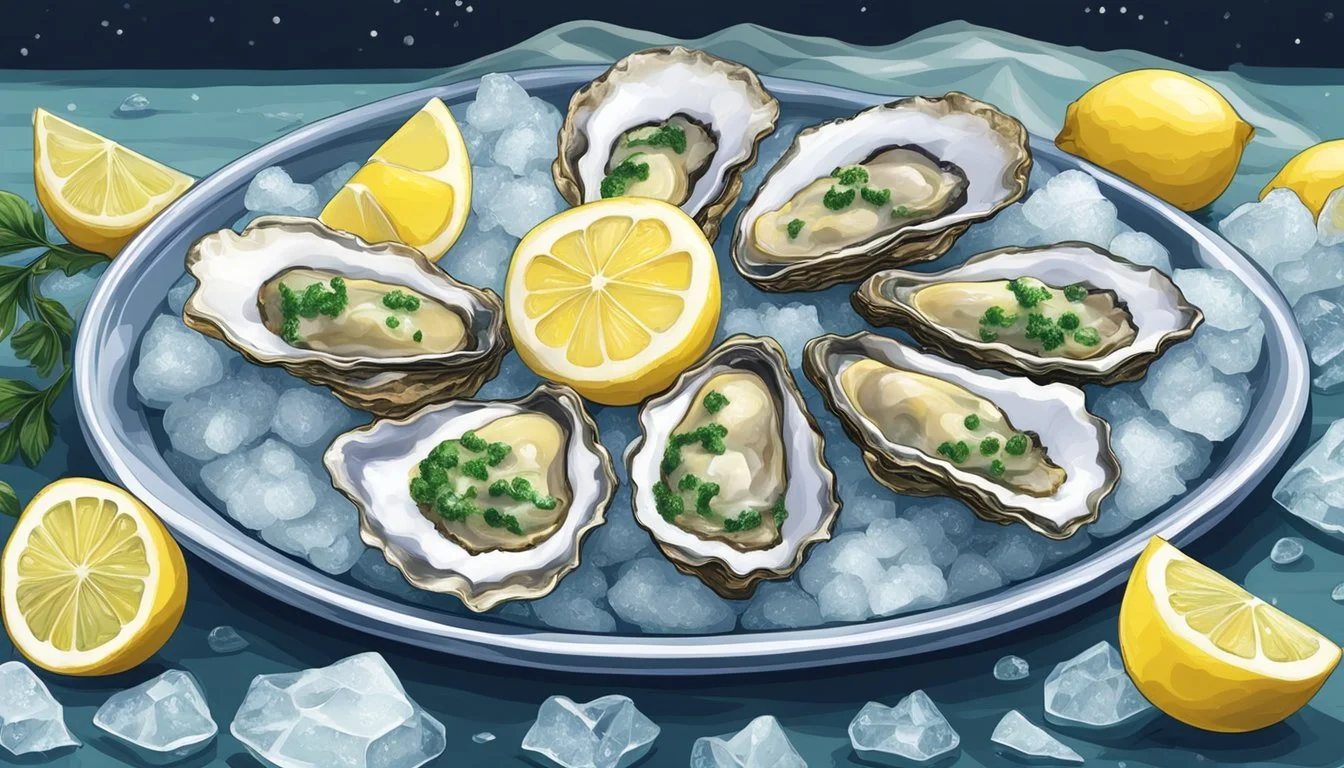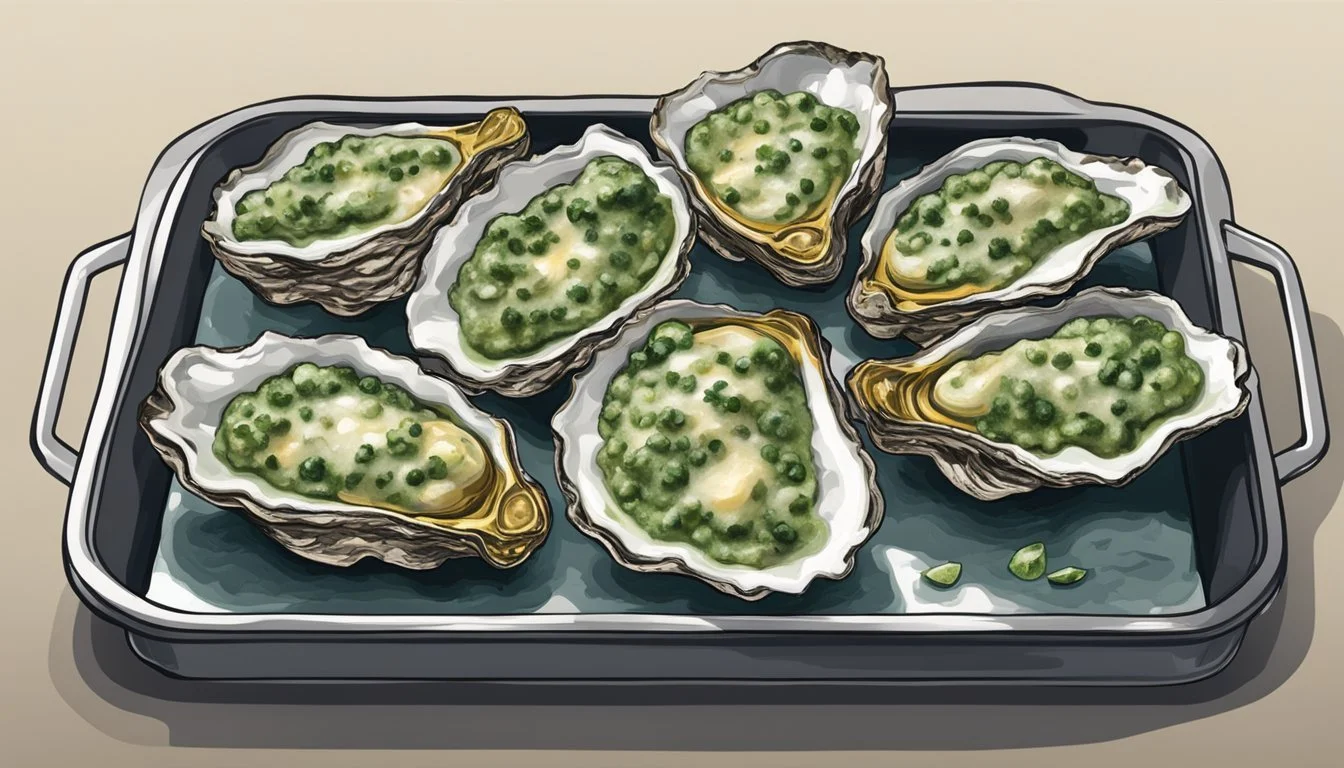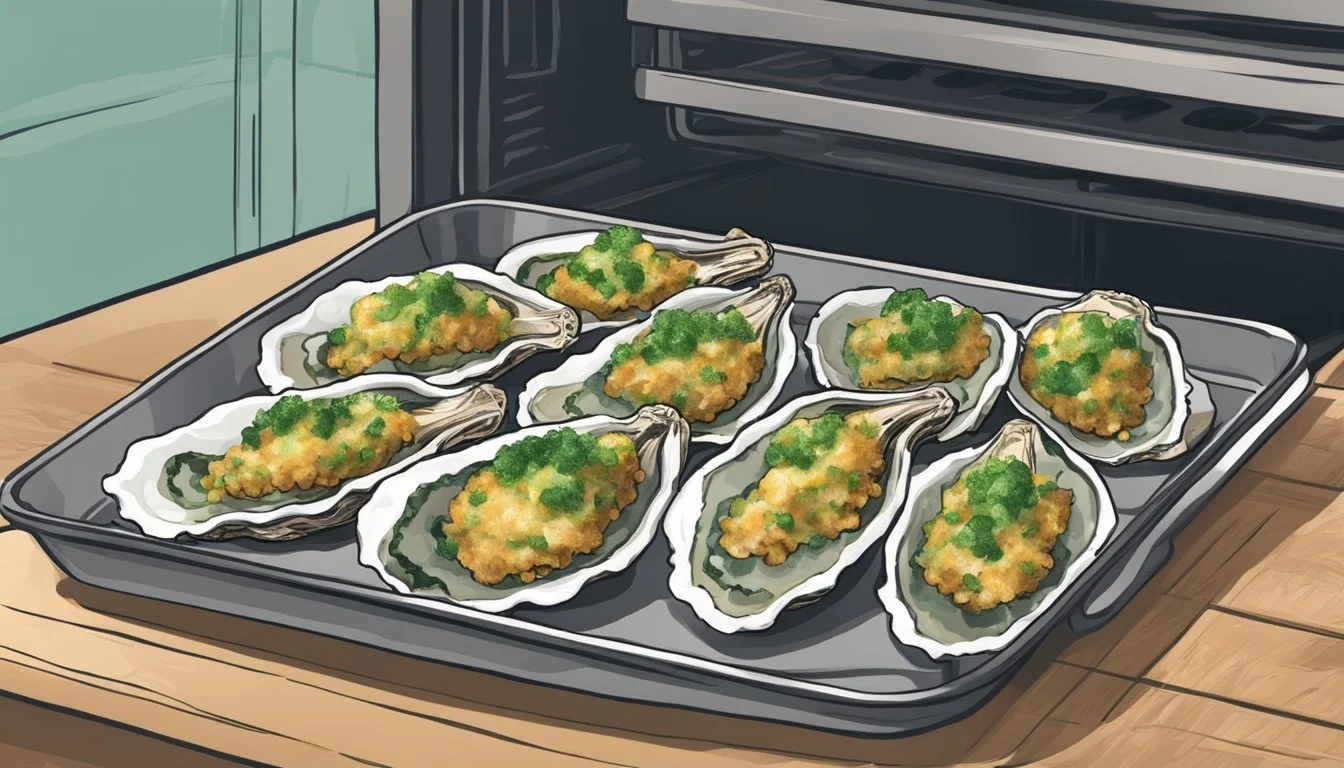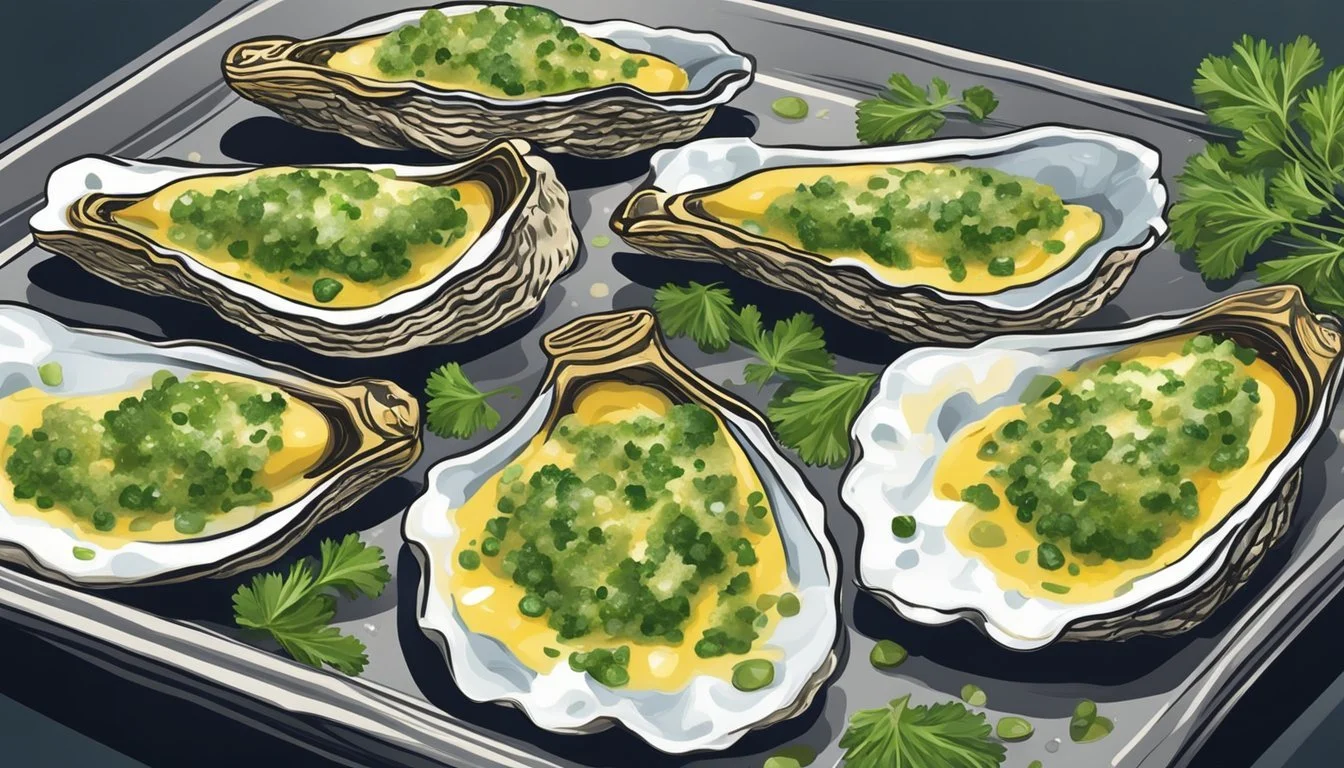Best Way to Reheat Oysters Rockefeller
Ensuring a Crisp Topping Every Time
Oysters (What wine goes well with oysters?) Rockefeller, a luxurious appetizer hailing from New Orleans, embodies the spirit of fine dining with its rich blend of flavors and textures. While enjoying them fresh out of the oven is a real treat, the challenge often arises when one has leftovers that need reheating. The key to recapturing the dish's initial allure lies in a reheating method that maintains the oysters' succulence and the topping's desirable crispness.
The art of reheating Oysters Rockefeller without compromising on quality requires careful consideration. Traditional microwaving, often used for its convenience, risks turning the delicate oysters rubbery and the cheese unappealingly oily. To ensure the topping remains crisp and the oysters tender, a specific approach is favored that involves the use of an oven to reinvigorate these decadent morsels. This method preserves the integrity of the oysters and the crunch of the breadcrumbs, making it the preferred technique for both restaurateurs and home chefs alike.
Understanding Oysters Rockefeller
Oysters Rockefeller is a luxurious dish characterized by its rich blend of flavors and textures. Made with select oysters topped with a herbaceous butter mixture and bread crumbs, this classic appetizer offers a taste of culinary history with every bite.
Historical Context
Oysters Rockefeller was created in 1899 at the famous Antoine's Restaurant in New Orleans by Jules Alciatore. The dish was named after John D. Rockefeller, the wealthiest American at the time, due to the richness of the sauce. Traditionally served on a bed of rock salt, which keeps them level and adds a slight saline touch, the dish has become emblematic of New Orleans cuisine.
Key Ingredients
The key to a classic Oysters Rockefeller includes:
Oysters: Fresh and plump, ideally of medium size for the perfect one-bite balance.
Breadcrumbs: Usually Panko for a lighter, crispier topping.
Cheese: A mixture of Parmesan and Pecorino Romano adds a sharp, nutty flavor.
Spinach: Either fresh baby spinach or quality frozen spinach, wilted and chopped, serves as the dish's green foundation.
Herbs and Aromatics: Parsley, shallot, and garlic are essential for flavor depth.
Liquor: Pernod or anise-flavored liqueur lends a distinct undertone, paying homage to classic French culinary practices.
Cream: Heavy cream enriches the topping, giving it a luxurious texture.
Seasoning: Rock salt not only serves as a cooking medium but also complements the oysters' natural salinity.
Nutritional Information
A typical serving of Oysters Rockefeller contains the following nutrients:
Nutrients Amount per Serving Calories Approx. 70-150 kcal Protein 2-6 g Fat 4-12 g (varying in saturated and unsaturated fats) Carbohydrates 3-10 g (mainly from breadcrumbs and spinach) Fiber 0.5-2 g Sugars 0.2-1.5 g Cholesterol 10-85 mg
It should be noted that these amounts can vary based on the recipe and serving size. Key nutritional components, such as iron and vitamin B12 from the oysters, are complemented by the vitamins A and C found in the spinach and herbs.
Preparation Techniques Before Reheating
Before reheating Oysters Rockefeller to achieve the optimal crispness of the topping, the preparation process is critical. This includes proper shucking techniques to keep the oyster intact, a sauté method to enhance the flavor profile of the ingredients, and assembly that ensures a consistent reheating process.
Proper Shucking
To begin, one needs a specialized oyster knife for accurate shucking, ensuring the oyster remains unharmed during the process. It's important to locate the hinge of the oyster shell, insert the knife, and twist to pop the shell open. One must then carefully sever the muscle that attaches the oyster to the shell, keeping the oyster and as much of its liquid in the bottom, deeper half of the shell for the best culinary experience.
Sauté Technique
Next, the shallots must be delicately sautéed to impart a nuanced flavor typical of seafood recipes. Over medium heat, one should sauté the shallots until they are translucent but not browned. To this, key ingredients such as lemon juice and cream can be added to create the rich sauce that characterizes Oysters Rockefeller. The sautéed shallots blend with breadcrumbs to form the base of the topping which adds texture and flavor.
Assembly for Optimal Reheating
Before they enter the oven for reheating, the oysters should be assembled strategically on the baking sheet, taking care to distribute shallot and breadcrumb topping evenly. This step assures each oyster is coated uniformly, allowing the heat to penetrate and crisp the topping effectively. When placed in a preheated oven, this careful assembly ensures that the flavors are preserved and that the texture reaches the desired crispness uniformly across all oysters.
Reheating Methods
Proper reheating of Oysters Rockefeller is crucial to preserve their rich flavor and crisp topping. Below are the most effective methods to achieve this.
Oven Reheating Method
To reheat in the oven, one should first preheat the oven to 375°F (190°C). Place the oysters on a baking sheet and cover them loosely with foil. This prevents them from drying out. The oysters should be heated for about 10 minutes or until they are hot and the cheese topping has melted adequately.
Equipment Needed: Oven, baking sheet, aluminum foil
Temperature: 375°F (190°C)
Time: 10 minutes
Skillet Reheating Method
Skillet reheating is ideal for those who wish to reheat fried oysters. Using a skillet over medium heat, add a small amount of oil or butter. Once the skillet is hot, add the oysters and heat for a couple of minutes on each side until they are crisped to the desired level.
Equipment Needed: Skillet, oil or butter
Heat: Medium
Time: A few minutes per side
Broiler Reheating Method
Reheating under a broiler is a quick method that can provide a crispy and golden crust. One should preheat the broiler, place the Oysters Rockefeller on a broiler pan, and broil them for 1-2 minutes while watching closely to avoid burning. Broiling is an intense heat process that requires constant attention.
Equipment Needed: Broiler, broiler pan
Time: 1-2 minutes
Attention Level: High
Maintaining Crispiness
The key to reheating Oysters Rockefeller while keeping the topping crisp lies in the choice of coating and the reheating method. Ensuring a crispy texture as the shellfish (What wine goes well with shellfish?) warms up will closely resemble the original freshness and crunch.
Using Panko Breadcrumbs
Panko breadcrumbs are preferred to standard breadcrumbs for their lighter, flakier texture, which crisps up exceptionally well. For maintaining crispiness, it is recommended to:
Sprinkle a fresh thin layer of panko breadcrumbs over the topping before reheating to add extra crunch.
Optionally, a light drizzle of olive oil on the panko can aid in achieving a more golden and crispy texture.
Oven Technique for Crisp Topping
Reheating Oysters Rockefeller in the oven is the most effective method for a crispy topping. Here are the steps:
Preheat the oven to a moderate temperature, typically around 350°F (175°C).
Arrange the oysters on a baking sheet, ideally on a rack to allow for even heat circulation.
Cover with foil to prevent the topping from burning or drying out.
Bake for about 8-10 minutes or until topping is hot and crispy.
Avoiding Common Mistakes
To avoid sogginess and ensure a crispy finish:
Do not microwave, as this can make the oysters rubbery and the cheese oily.
Avoid overloading the oysters with cheese or wet ingredients before reheating which can cause steam and lead to a soggy topping.
Parmesan, when used sparingly, can contribute to the crispiness of the topping due to its low moisture content.
Storage Solutions
Proper storage is crucial for maintaining the texture and taste of leftover Oysters Rockefeller. These methods ensure that the oysters remain delicious when reheated.
Short-term Storage
For those planning to enjoy their Oysters Rockefeller within a couple of days, short-term storage in the refrigerator is the best option. They should place the leftover oysters in an airtight container to prevent them from absorbing other flavors or odors present in the refrigerator. To further ensure the topping remains crisp, they can line the container with parchment paper, which will help absorb any excess moisture.
Freezing and Long-term Storage
When it comes to freezing Oysters Rockefeller for long-term storage, one should take great care to preserve their quality. The oysters can be placed on a baking sheet lined with parchment paper and then put in the freezer until solid. After they're frozen, they should be transferred into airtight containers or heavy-duty freezer bags to prevent freezer burn. Labeling the container with the date will help keep track of how long they've been stored. The ideal freezing time for Oysters Rockefeller is up to 3 months, which helps in maintaining a desirable texture upon reheating.
Serving Suggestions
When presenting Oysters Rockefeller, the choice of accompanying beverages and complementary seafood appetizers can elevate the dining experience. The key is to select flavors that harmonize with the rich and savory profile of the Oysters Rockefeller, ensuring that each sip and bite enhances the overall enjoyment of the meal.
Accompanying Beverages
White Wines:
Sauvignon Blanc: Its crispness cuts through the richness of the oysters.
Pinot Grigio: A lighter option that complements without overpowering the flavors.
It is suggested to opt for wines that offer a balance to the dish's creamy and crispy topping, ideally with a hint of acidity such as lemon to cleanse the palate.
Pairing with Other Seafood Appetizers
Cold Appetizers:
Shrimp Cocktail: (What wine goes well with shrimp?)The cool, briny shrimp provides a textural contrast.
Stuffed Clams: (What wine goes well with clams?) A mouthful of distinct but complementary shellfish flavors.
Warm Appetizers:
Crab Cakes (What wine goes well with crab cakes?): Share the spotlight by adding these rich, succulent cakes.
Seared Scallops: Offer a tender and mildly sweet counterpoint.
Fried Calamari: Presents a crispy, yet tender juxtaposition to the baked oyster topping.
These selections are crafted to align with the sophisticated nature of the Oysters Rockefeller, creating a symphony of seafood delights that are perfect for starters at a dinner gathering.
Understanding Reheating Safety
When reheating Oysters Rockefeller, it is essential to maintain food safety by adhering to proper temperature guidelines and utilizing a food thermometer to ensure precise cooking.
Food Temperature Guidelines
The United States Department of Agriculture (USDA) recommends reheating all leftovers to an internal temperature of 165°F. This guideline helps to eliminate any potentially harmful bacteria that may have developed during storage. Oysters Rockefeller, being a seafood dish with a rich topping, requires careful heating to maintain its quality while also ensuring safety.
Steps for reheating:
Preheat the oven—this cooking method helps keep the topping crisp.
Avoid using a microwave, as it can make the oysters tough and the cheese oily.
Using a Food Thermometer
A food thermometer is a dependable tool for checking if Oysters Rockefeller has been reheated to a safe temperature. Here's how to properly use a thermometer when reheating this dish:
Insert the thermometer into the thickest part of the oyster topping.
Wait for the reading to stabilize before removing the thermometer.
Remember:
Do not touch the thermometer probe to the shell as it can give a false reading.
Ensure the thermometer reads 165°F to confirm the dish is safely reheated.
By adhering to these safety measures, one can enjoy their Oysters Rockefeller reheated to the right temperature with the topping crisp and delicious.
Engaging Your Senses
When reheating Oysters Rockefeller, paying attention to the sensory changes can lead to outstanding results that delight both the eyes and nose. One must observe visual and aromatic signs to ensure the topping remains crisp while maintaining its high rating among seafood dishes. (What wine goes well with seafood dishes?)
Visual Cues for Perfect Reheat
Color: The oysters should achieve a rich golden-brown hue; an indicator they have been warmed sufficiently.
Texture: A crisp topping, evident from a gentle sizzle of cheese or breadcrumbs, suggests readiness without overcooking.
Observations must be made periodically to prevent the seafood from losing its desired crispness. The use of olive oil in the original preparation can yield a glistening appearance upon reheating, while the sprinkle of black pepper may become more pronounced as the oysters are brought back to temperature.
Aromatic Clues During Cooking
Onion and Black Pepper: The aroma of onion should be noticeable with a hint of black pepper, indicating the oysters are warm throughout.
Seafood Freshness: A distinct oceanic scent should remain, signaling the quality of the seafood has been preserved during the reheating process.
Comments on the dish often highlight the aromatic experience, which is why one should take cues from these scents to determine when the Oysters Rockefeller are ready to be removed from the oven.
Alternatives to Oysters Rockefeller
Frequent diners and home chefs alike often seek variety in their appetizers (What wine goes well with appetizers?). Alternatives to Oysters Rockefeller can maintain the original dish's sophistication while catering to different tastes or dietary restrictions.
Similar Seafood Starters
Crab (What wine goes well with crab?) cakes: Renowned for their rich flavor and versatile nature, crab cakes serve as a suitable alternative. They typically consist of lump crab meat bound with breadcrumbs, mayonnaise, and eggs, and are seasoned with herbs and spices before being pan-fried or baked to achieve a crispy exterior.
Shrimp cocktail: This classic appetizer offers the simplicity of poached shrimp served with a tangy cocktail sauce. Shrimp cocktail is praised for its ease of preparation and can be a refreshing start to any meal.
Vegetarian Options
Stuffed portobello mushrooms: They offer a hearty texture that makes them an excellent base for various fillings. A popular preparation includes stuffing portobello caps with a blend of breadcrumbs, cheese, garlic, and herbs before baking until golden.
Grilled or baked eggplant: Slices of eggplant can be marinated and either grilled or baked as a delicious starter. The flesh of the eggplant becomes tender, absorbing the flavors of the marinade, and can be served with a drizzle of balsamic reduction or sprinkling of feta cheese.
Conclusion
When reheating Oysters Rockefeller, attention to detail is crucial for maintaining the integrity of the dish. Oysters themselves are delicate, and their topping is what defines the Rockefeller experience, requiring a method that stays true to its celebrated crispiness.
Utilizing an oven is the unanimous choice. It is recommended to reheat at a temperature range of 350°F to 400°F (175°C to 200°C) for about 8 to 10 minutes. Ensuring the dish is covered with foil can prevent drying out, preserving the moisture of the oysters underneath.
Upon completing the reheating process, the eating experience is expected to be on par with the initial serving. The Oysters Rockefeller's topping should exude a crisp texture, with a golden hue indicative of a well-executed gentle warming.
In summary, the method employed should respect the original preparation of the Oysters Rockefeller, support the tenderness of the oyster, and reheat the topping to a point where it is delightfully crisp yet not overly done. Abstain from using a microwave as this may not yield the desired results. Achieving the pinnacle of reheated seafood appetizers is certainly possible with these considerations in mind.








